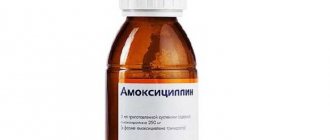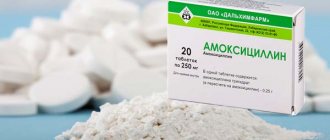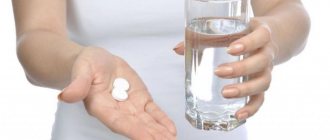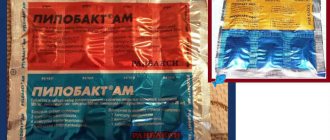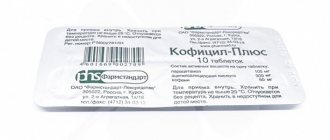Composition of the drug
Tablets: 500 mg amoxicillin + 125 mg clavulinic acid. Other components: primellose, derivatives of silicon, magnesium and titanium, CMC, crospovidone, povidone, PET, lactose and other substances.
Tablets: 875 mg amoxicillin + 125 mg clavulinic acid. The composition of additional components is identical to the pills described above.
Powder for preparing solutions is available in three types with different contents of active substances. The ratio of amoxicillin and clavulinic acid in 5 ml of medication:
- 125 mg + 31.25 mg
- 250 mg + 62.5 mg
- 400 mg + 57.10 mg
Auxiliary ingredients are given in the same composition: silicon dioxide, food stabilizer E464 (hydroxypropyl methylcellulose), sweetener, saccharin, succinic acid, flavorings and other elements.
Medicinal properties
The therapeutic effect of Amoxicar Plus is due to the properties of its main components:
- Amoxicillin is a substance that is a semisynthetic antibiotic of the penicillin group. It has a strong antimicrobial effect on most pathogens, but is very sensitive to β-lactamase (bacterial enzyme), and therefore cannot suppress microorganisms containing it.
- Clavulinic acid also belongs to semisynthetic antibiotics, but its structure contains beta-lactamase. Therefore, the substance is capable of inhibiting infection that is not susceptible to the first component.
The inclusion of two complementary substances into one medicine made it possible to achieve the powerful bactericidal effect of Amoxicar Plus. The drug actively suppresses most gram-positive and gram-negative microorganisms.
After administration, the substance is actively absorbed, and after an hour the concentration in the blood reaches peak levels. The drug is distributed throughout almost the entire body, penetrates the placenta and is excreted in small quantities (in the form of traces) into breast milk.
Amoxicillin is partially transformed, while clavulinic acid is metabolized to a significant extent. Drug components and their compounds are excreted by the kidneys, partly by the intestines and lungs.
pharmachologic effect
The mechanism of drug action is due to the presence of clavulanic acid and amoxicillin (an antibiotic). These substances disrupt the growth and reproduction of bacteria. The drug is active against aerobic microbes (staphylococcus, klebsiella, streptococcus, shigella, neisseria); it is not prescribed if the inflammation is caused by bacteria that produce beta-lactamase.
Pharmacodynamics and pharmacokinetics
When the medicine enters the patient's body, rapid absorption occurs. Absorption is not reduced by food intake. The peak level of antibiotic in the blood is recorded 60 minutes after taking the tablets (suspension).
Traces of the drug are found in tissues and in all biological fluids of the body: sinus secretions, synovial fluid, bronchial secretions. After 2 hours the concentration reaches its maximum.
Amoxicar is excreted through the kidneys, intestines and lungs. Half-life is from 1 to 1.5 hours. In kidney disease it is greater. The antibiotic is excreted in about 7 hours, the acid is 4.
Diseases for which the medicine is used Diseases of the ENT organs, the cause of which is a bacterial infection susceptible to the active substances of the drug "Amoxicar":
- pharyngitis;
- sinusitis (chronic);
- tonsillitis;
- otitis;
- abscess.
Release forms
Amoxicar Plus is produced in two pharmaceutical forms:
Tablets of 500 and 845 mg of amoxicillin are oval pills enclosed in a white shell. The difference is that there is a dividing strip on the surface of the latter. The tablets are packaged in plastic bottles, enclosed with instructions in a pack of thick paper. 500 mg pills – 20 pieces each, 875 mg product – 14 pieces each.
The powder for preparing the solution is a fine, free-flowing mass of white color with the taste and aroma of orange and strawberry. The drugs are packaged in dense polyethylene bottles, placed in packs with instructions and a dosage cup: powders 125 mg/31.25 mg and 250 mg/62.5 mg - 100 ml each, product 70 mg/57 mg - 70 ml each.
Mode of application
The dosage and duration of taking Amoxicar Plus is determined by the treating specialist, and many indicators are taken into account: the severity of the condition, the weight and age of the patient, concomitant diseases, kidney function, etc. The duration of the course is 2 weeks. To enhance the therapeutic effect of the drug, it is better to drink it at the beginning of the meal.
Patients (from 12 years of age) or weighing more than 40 kg are recommended to take tablets depending on their dosage. When calculating, they are guided by the content of amoxicillin:
- (500 mg): 1 t. x 3 times (interval - 8 hours)
- (875 mg): 1 t. x 2 times (after 12 hours).
For children under 12 years of age or weighing less than 40 kg, the dosage is calculated from the ratio of 40 mg per 1 kg of weight and the resulting amount is given in three doses.
For newborns and infants up to 3 months of age, the antibiotic is given in suspension. Proportion for dosage calculation: 25 mg of amoxicillin per kilogram of weight. Give in three doses.
For babies from 3 months, the proportion is 45 mg per kilogram, taken three times a day.
The instructions for use of Amoxicar Plus in powder form advise preparing it before the first dose. To do this, the filling of the bottle is diluted in boiled water at room temperature in the proportion recommended by the doctor. After preparation, the solution retains its healing properties for a week. Keep in the refrigerator.
Special instructions
Long-term use of Amoxicar Plus can provoke the proliferation of pathogenic bacteria in the intestines that are resistant to the effects of amoxicillin. Long-term treatment with a penicillin antibiotic requires monitoring of liver and kidney functions.
If necessary, patients with liver or kidney pathologies change the treatment regimen, adjusting the dosage.
Simultaneous use of Amoxicar Plus and an anticoagulant requires monitoring of prothrombin time, in some cases its increase is observed.
During pregnancy and pregnancy
Animal studies have not recorded any disturbances in fetal development. But since there is no accurate data yet on the specific effects of active substances on the human body, the use of Amoxicar Plus during pregnancy is undesirable. Medicine can be prescribed in case of special need, after analyzing the balance of harm and benefit.
The drug is approved for use during lactation, as no negative effects on the child have been recorded. However, it must be taken into account that traces of the drug in milk can cause hypersensitivity.
Contraindications
Amoxicar Plus is not prescribed for:
- Individual reaction of the body to the main or auxiliary components
- History of cases of hypersensitivity to antibiotics of the penicillin, cephalosporin and lactam groups
- If there is a history of cholestatic jaundice
- Liver dysfunction after therapy with drugs containing the same substances as Amoxicar Plus
- Infectious mononucleosis
- Hereditary metabolic disorder of the amino acid phenylalanine (phenylketonuria).
Drugs should be taken with caution if there is liver failure, complex kidney pathologies, and also during breastfeeding.
Take this medicine with caution
Amoxicar is prescribed with extreme caution and under strict medical supervision during pregnancy and breastfeeding.
In addition, caution should be exercised when prescribing the drug to patients with kidney or liver failure, severe stomach or intestinal diseases, urticaria and hay fever.
Amoxicar should be taken for several days after all clinical manifestations of the pathology have disappeared.
Precautionary measures
Before starting treatment, it is necessary to ensure that there is no history of allergic reactions to penicillins and cephalosporins. Otherwise, rapid development of hypersensitivity up to severe conditions is possible.
If long-term therapy with Amoxicar Plus is prescribed, then during its course it is necessary to monitor the state of the hematopoietic system, liver and kidney function.
It must be taken into account that during a course of treatment with the drug, the risk of developing drug resistance in microorganisms increases.
Patients with severe kidney pathologies require dosage adjustment or an increase in the interval between doses.
To avoid the development of side effects, it is better to drink Amoxicar Plus during meals.
People with impaired diuresis may develop crystalluria. To minimize the risk of its occurrence, the required level of hydration and diuresis should be maintained during treatment.
Amoxicar plus tablets po 500 mg 125 mg blisters No. 20
AMOXICAR PLUS Trade name of the drug: Amoxicare Plus, Amoxicare Plus. INN: amoxicillin, clavulanic acid.
Release form: film-coated tablets; — powder for the preparation of a suspension for oral administration.
Composition Amoxicar Plus film-coated tablets, 500 mg/125 mg Each tablet contains: active ingredients: amoxicillin 500 mg (as trihydrate), clavulanic acid 125 mg (as potassium clavulanate); excipients: croscarmellose sodium, magnesium stearate, colloidal silicon dioxide, talc powder, microcrystalline cellulose, crospovidone XL, povidone PVP K30, opadry OY-L-28920 white: polyethylene glycol, titanium dioxide, lactose monohydrate, hypromellose.
Amoxicar Plus film-coated tablets, 875 mg/125 mg Each tablet contains: active ingredients: amoxicillin 875 mg (as trihydrate), clavulanic acid 125 mg (as potassium clavulanate); excipients: croscarmellose sodium, magnesium stearate, colloidal silicon dioxide, talc powder, microcrystalline cellulose crospovidone XL, povidone PVP K30, opadry OY-L-28920 white: polyethylene glycol, titanium dioxide, lactose monohydrate, hypromellose.
Amoxicar Plus powder for the preparation of 100 ml of oral suspension 125 mg + 31.25 mg/5 ml in a 5 ml suspension bottle contains: active ingredients: amoxicillin 125 mg (in the form of trihydrate), clavulanic acid 31.25 mg (in the form of clavulanate potassium); excipients: silicon dioxide, aspartame, hydroxypropyl methylcellulose, orange flavor, finely dispersed silicon dioxide, sodium saccharin, strawberry flavor, succinic acid, colloidal silicon dioxide, xanthan gum.
Amoxicar Plus powder for the preparation of 100 ml of oral suspension 250 mg + 62.5 mg/5 ml in a 5 ml suspension bottle contains: active ingredients: amoxicillin 250 mg (in the form of trihydrate), clavulanic acid 62.5 mg (in the form of potassium clavulanate); excipients: silicon dioxide, aspartame, hydroxypropyl methylcellulose, orange flavor, finely dispersed silicon dioxide, sodium saccharin, strawberry flavor, succinic acid, colloidal silicon dioxide, xanthan gum.
Amoxicar Plus powder for the preparation of 70 ml of suspension for oral administration 400 mg + 57.10 mg/5 ml in a bottle of 5 ml of suspension contains: active ingredients: amoxicillin 400 mg (in the form of trihydrate), clavulanic acid 57.10 mg (in the form of potassium clavulanate); excipients: silicon dioxide, aspartame, hydroxypropyl methylcellulose, orange flavor, finely dispersed silicon dioxide, sodium saccharin, strawberry flavor, succinic acid, colloidal silicon dioxide, xanthan gum.
Description Film-coated tablets 500 mg/125 mg: oval tablets, white film-coated; 875 mg/125 mg: oval tablets, with a separating line on one side, covered with a white film coating Powder for the preparation of a suspension for oral administration 125 mg + 31.25 mg/5 ml: free-flowing fine powder of white or almost white color with the smell and taste of orange and strawberry . 250mg+62.5mg/5ml: free-flowing fine powder of white or almost white color with the smell and taste of orange and strawberry. 400m g+5 7mg/5 ml: free-flowing fine powder of white or almost white color with the smell and taste of orange and strawberry.
Pharmacotherapeutic group Beta-lactam antibiotics - penicillins for systemic use. Amoxicillin in combination with β-lactamase inhibitors.
ATX code: J01CR02
Pharmacological properties Pharmacodynamics A combined drug containing amoxicillin, a semi-synthetic penicillin antibiotic with a broad spectrum of bactericidal action, and clavulanic acid, an inhibitor of bacterial β-lactamases. Amoxicillin is sensitive to β-lactamases and is destroyed as a result of their action, therefore the spectrum of its antibacterial activity does not include microorganisms that synthesize this enzyme. Clavulanic acid has a β-lactam structure similar to that of penicillins and is capable of binding and inactivating bacterial β-lactamases, thereby preventing the hydrolysis of beta-lactam antibiotics. It, ensuring the resistance of amoxicillin to the effects of β-lactamases, expands the spectrum of its action, including many microorganisms resistant to amoxicillin or other penicillins and cephalosporins. Amoxicar Plus has a wide spectrum of antibacterial action. Active against amoxicillin-resistant bacteria, including strains that produce β-lactamases: Gram-positive aerobic bacteria: Staphylococcus aureus (except methicillin-resistant strains), coagulase-negative staphylococci (including Staphylococcus epidermidis), Streptococcus agalactiae, Streptococcus pneumoniae, Streptococcus py ogenes, Streptococcus viridans, Corynebacterium spp., Enterococcus faecalis, Enterococcus faecium, Listeria monocytogenes, Nocardia asteroides, Bacillus anthracis; Gram-positive anaerobic bacteria: Clostridium spp., Peptococcus spp., Peptostreptococcus spp.; Gram-negative aerobic bacteria: Bordetella pertussis, Brucella spp., Escherichia coli, Gardnerella vaginalis, Haemophilus influenzae, Helicobacter pylori, Klebsiella spp., Legionella spp., Moraxella catarrhalis (Branhamella catarrhalis), Neisseria gonorrhoeae, Neisseria meningitidis, Pasteurella multocida, Proteus mir abilis Proteus vulgaris, Salmonella spp., Shigella spp., Vibrio cholerae, Yersinia enterocolitica; Gram-negative anaerobic bacteria: Bacteroides spp. (including Bacteroides fragilis), Fusobacterium spp.; other microorganisms: Borrelia burgdorferi, Chlamydia spp., Leptospira Pharmacokinetics Rapidly absorbed after oral administration (food has no effect on absorption). Cmax is reached 1 hour after administration and is (depending on the dose) for amoxicillin 3-12 mu/ml, for clavulanic acid - about 2 μg/ml. Has a large volume of distribution; high concentrations are found in body fluids and tissues (lungs, pleural, peritoneal, synovial fluid, tonsils, bronchial secretions, prostate gland, liver, tonsils, muscle tissue, adipose tissue, paranasal sinus secretions, middle ear, etc. .). Peak concentrations in body fluids are observed 1 hour after peak plasma concentrations are reached. Does not pass through the BBB when the meninges are not inflamed, passes through the placental barrier and penetrates into breast milk in trace concentrations. Weakly binds to blood plasma proteins. Amoxicillin is partially metabolized, clavulanic acid undergoes more intensive metabolism. Amoxicillin is excreted by the kidneys almost unchanged by tubular secretion and glomerular filtration; clavulanic acid by glomerular filtration, partly in the form of metabolites. Small amounts are excreted by the intestines and lungs. T1/2 is 1-1.5 hours, with severe renal failure it increases to 7.5 (for amoxicillin) and 4.5 hours (for clavulanic acid). Removed by hemodialysis, slightly removed by peritoneal dialysis.
Indications for use Treatment of bacterial infections caused by microorganisms sensitive to the drug, including: - infections of the upper respiratory tract and JIOP organs including acute and chronic sinusitis, acute and chronic otitis media, retropharyngeal abscess, tonsillitis, pharyngitis); - lower respiratory tract infections, including chronic bronchitis in the acute phase, pneumonia; - genitourinary tract infections, including cystitis, urethritis, pyelonephritis, infections of the female genital organs and gonorrhea; - infections of the skin and soft tissues; — infections of the musculoskeletal system, including osteomyelitis; - other infections, including septic abortion, postpartum sepsis, intra-abdominal sepsis, septicemia, peritonitis, postoperative infectious complications.
Method of administration and dosage regimen The dosage regimen is set individually depending on the age, body weight, renal function of the patient and the severity of the infection. For optimal absorption and reduction of possible side effects, Amoxicar Plus is recommended to be used at the beginning of meals. Treatment should not be continued for more than 14 days without reviewing the clinical situation. Dosages of the drug are given for amoxicillin. Orally, adults and children over 12 years of age or weighing more than 40 kg: 1 tablet 500 mg/125 mg every 8 hours (3 times a day) or 1 tablet 875 mg/125 mg 2 times a day. Children under 12 years of age or with a body weight of less than 40 kg. The dose, depending on age and body weight, is indicated in mg/kg body weight per day or in ml of suspension. It is proposed to use the dosage regimen for amoxicillin: 40 mg/kg/day, divided into 3 doses, or 45 mg/kg/day, divided into 2 doses. For children weighing 40 kg or more, dosing is carried out in accordance with recommendations for adults. Newborns and children up to 3 months With a body weight <4 kg - 25/5 mg/kg (amoxicillin) every 12 hours. With a body weight >4 kg - 25/5 mg/kg every 8 hours. The use of a 125 mg suspension is recommended + 31.25 mg/5 ml. Children over 3 months - 45 mg/kg/day, divided into 2 doses or 40 mg/kg/day in 3 doses (every 8 hours). There are no clinical data regarding the use of doses exceeding 45 mg/kg/day in children under 2 years of age. Single doses of the drug Amoxicar Plus, depending on age and weight, are given in the table (see the Instructions attached to the drug). The optimal dosage form for children from 6 to 12 years old is 500/125 mg tablets taken 2 times a day. The use of amoxicillin/potassium clavulanate at a dose of 20-30 mg/kg/day is possible for recurrent tonsillitis, infections of the skin and soft tissues (superficial abscesses, animal bites, infection of a surgical wound). Amoxicar Plus tablets (875 mg/125 mg) are not recommended for use in children under 12 years of age. Dosing for renal impairment: In case of renal failure, it is necessary to reduce the dose or increase the interval between doses (with a creatinine clearance of 10-30 ml/min, the interval between doses is 12 hours, less than 10 ml/min 24 hours). Amoxicar Plus (875 mg/125 mg) is prescribed only for the treatment of patients with creatinine clearance >30 ml/min. In case of renal failure with creatinine clearance <30 ml/min, Amoxicar Plus (875 mg/125 mg) is not used. Dosage for hemodialysis: 1 tablet 500 mg/125 mg per day. Additionally - 1 tablet during the session and at the end of dialysis (taking into account the decrease in the concentrations of amoxicillin and clavulanic acid in the blood serum). Preparation of the suspension The suspension is prepared immediately before the first use. Dilute the powder contained in the bottle with chilled boiled water, as indicated on the package. The bottle should be shaken before each use. Use a measuring cap to ensure accurate dosage of the drug. After dilution, store the suspension for no more than 7 days in the refrigerator.
Side effects From the digestive system: nausea (when using large doses), vomiting, diarrhea; rarely: dyspepsia, moderate increase in liver transaminases (clinical significance unknown); very rare: antibiotic-associated colitis (including pseudomembranous and hemorrhagic colitis), hepatitis. Side effects from the gastrointestinal tract that occur during oral therapy can be reduced by using Amoxicar Plus at the beginning of a meal. From the hematopoietic system: rarely: reversible leukopenia (including neutropenia) and thrombocytopenia; very rarely; reversible agranulocytosis and hemolytic anemia, increased bleeding time and prothrombin index. Allergic reactions: itching, urticaria, skin rashes; very rarely angioedema, bronchospasm, serum sickness-like syndrome, allergic vasculitis, anaphylactic shock. From the nervous system: uncommon: dizziness, headache. Very rare: reversible hyperactivity and seizures. Convulsions may occur in cases of impaired renal function or in patients receiving high doses of the drug. Other: development of superinfection (including candidiasis of the skin and mucous membranes), very rarely: interstitial nephritis, crystalluria. In most cases, side effects are mild and transient.
Contraindications: hypersensitivity to amoxicillin and/or clavulanic acid; history of hypersensitivity to β-lactam antibiotics, including penicillins and cephalosporins; history of cholestatic jaundice or impaired liver function after use of amoxicillin/clavulanic acid. — infectious mononucleosis (including with the manifestation of a measles-like rash). - phenylketonuria.
Use during pregnancy and lactation. No teratogenic effects were found in experimental reproductive studies on animals. Prescribing the drug during pregnancy should be avoided, unless the benefit of the drug for the mother outweighs the potential risk to the fetus. Amoxicar Plus can be used during breastfeeding. With the exception of the risk of sensitization associated with the excretion of trace amounts of Amoxicar Plus into breast milk, no harmful effects have been detected on the breastfed baby.
Warnings and special instructions Before starting therapy with Amoxicar Plus, it is necessary to exclude a history of hypersensitivity reactions to penicillins and cephalosporins. Severe, sometimes fatal hypersensitivity reactions (anaphylactoid reactions) to penicillin therapy have been described. These reactions are most likely in individuals with a history of similar reactions to antibiotics of this group. If allergic reactions occur, treatment with Amoxicar Plus should be discontinued and alternative therapy should be prescribed. Severe anaphylactic reactions require emergency treatment with epinephrine, oxygen therapy, IV administration of corticosteroids and provision of pulmonary function, including intubation. Amoxicar Plus should not be prescribed if infectious mononucleosis is suspected, since cases of measles-like rash have been reported with the use of amoxicillin for this pathology. Long-term use of the drug may cause activation of microflora resistant to Amoxicar Plus. Amoxicar Plus is usually well tolerated and exhibits low toxicity inherent in penicillin antibiotics. However, with prolonged use, functional indicators of the kidneys, liver and hematopoiesis should be periodically monitored. Amoxicar Plus should be used with caution in patients with impaired liver function. In patients with severe renal impairment, the dosage regimen must be adjusted according to the severity of renal failure. Occasionally, patients taking Amoxicar Plus experience an increase in prothrombin time. When taking anticoagulants concomitantly, appropriate monitoring is necessary. High concentrations give a false positive reaction for glucose in urine when using Benedict's reagent or Felling's solution (it is recommended to use enzymatic reactions with glucose oxidase). Crystalluria very rarely occurs in patients with reduced diuresis. Therefore, to reduce the risk of its occurrence during treatment with the drug in high doses, it is recommended to ensure adequate hydration and diuresis.
Effects of overdose Symptoms: in most cases nausea, diarrhea, vomiting, possible agitation, insomnia, dizziness, and in some cases seizures. There are no reports of deaths or life-threatening side effects. Treatment: symptomatic, in case of recent use (less than 4 hours), remove the drug from the gastrointestinal tract (gastric lavage, taking activated charcoal to reduce absorption); Correction of water and electrolyte disturbances is carried out, hemodialysis is effective.
Interaction with other drugs, food products With the simultaneous use of indirect anticoagulants and Amoxicar Plus, an increase in bleeding time and prothrombin time was noted in some patients. This combination is prescribed with caution. Concomitant use of probenecid is not recommended because it reduces the tubular secretion of amoxicillin. Its simultaneous use with Amoxicar Plus can lead to an increase in the level of amoxicillin in the blood plasma for a long time; does not affect the level of clavulanic acid. Concomitant use of allopurinol during treatment with amoxicillin increases the risk of developing allergic skin reactions. There are no data regarding the simultaneous use of Amoxicar Plus and allopurinol. Like other broad-spectrum antibiotics, Amoxicar Plus may reduce the effectiveness of oral contraceptives, which patients should be warned about. The effectiveness of Amoxicar Plus is weakened by combination with bacteriostatic antibiotics (macrolides, tetracyclines), sulfonamides; combination with rifampicin is antagonistic.
Impact on the ability to drive vehicles and work with
Cross-drug interactions
When treating with Amoxicar Plus, it is necessary to take into account the characteristics of reactions with other drugs:
- When combined with indirect anticoagulants, the duration of bleeding may increase.
- It is not recommended to take an antibiotic with Probenecid due to the risk of increasing the concentration of amoxicillin in the blood.
- Combination with Allopurinol contributes to the development of skin allergies.
- An antibiotic may reduce the effectiveness of birth control.
- Simultaneous use with antibiotics of other groups reduces the effect of Amoxicar. It should absolutely not be combined with Rifampicin.
Indications for use
Indications for use of the drug are:
- Pneumonia.
- Bronchitis.
- Pharyngitis.
- Sinusitis.
- Otitis media in acute form.
- Pyelitis.
- Tonsillitis.
- Gonorrhea.
- Pyelonephritis.
- Cystitis.
- Urethritis.
In addition, Amoxicar Plus is used as part of complex therapy for the following pathologies:
- Cervicitis.
- Endometritis.
- Cholecystitis.
- Erysipelas.
- Cholangitis.
- Lyme disease.
- Dermatosis of a secondary infected type.
- Meningitis.
- Sepsis.
- Salmonellosis.
- Listeriosis.
- Peritonitis.
- Endocarditis.
A prerequisite for taking the drug is to obtain a prescription from a doctor, since its independent use can cause the development of unwanted reactions and complications.
Side effects
Therapy with Amoxicar Plus may be accompanied by side effects of the drug. In general, the symptoms are not very pronounced and disappear after stopping the medication. Manifest in the form:
- Nausea, vomiting
- Diarrhea
- Abdominal pain
- Failure of normal liver function, activation of its enzymes
- Hepatitis A
- Cholestatic jaundice
- Skin reactions (itching, rashes)
- Erythema
- Disorders of the hematopoietic organs
- Headache
- Seizures (mainly in people with kidney pathologies after taking overdoses of drugs)
- Excited state
- Increased nervousness, anxiety
- Insomnia
- Interstitial nephritis.
Overdose
In most cases, the medicine is accepted by the body normally. Negative phenomena that may accompany a course of Amoxicar Plus manifest themselves in the form of:
- Nausea, vomiting
- Nervous excitement
- Sleep disorders, insomnia
- Vertigo
- Convulsive seizures (very rare).
There is no information about the development of life-threatening conditions or fatal outcome.
To eliminate the negative consequences, first of all, you need to stop the drug, rinse the stomach (if less than four hours have passed since the last dose), and give the sorbent to drink. If necessary, hemodialysis is performed.
Analogs
There are other drugs that are identical in action to Amoxicar Plus.
Amoxiclav
LEK dd (Slovenia)
Price: powder (6 flasks) – 450 rubles, tablets (15 pcs.) – 275-400 rubles, powder d/susp. 109-287 rub.
A drug with a similar composition of main components and action. The antibiotic is used to treat infections of various organs. It is produced in the form of powders for injections and oral suspensions, tablets.
Contraindications and method of use are similar to Amoxicar Plus.
Pros:
- Treats many infections
- Affordable price.
Flaws:
- Large tablet size
- May cause gastrointestinal upset.
Conditions for dispensing from the pharmacy, cost of the drug
Dispensed by prescription only, price depends on the type of pharmacy chain.
How to store the medicine correctly and for how long. Store the tablets in sealed packaging for 3 years in a residential area at an air temperature of 22-25 °C. Shelf life is limited to 2 weeks after opening the bottle.
The powder for the suspension in an unopened bottle is stored at room temperature for 3 years, the finished suspension can only be stored in the refrigerator. It must be consumed within 7 days, do not freeze.
